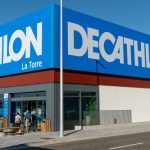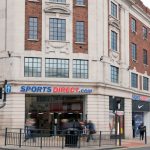In an interview with SGB Executive, Steve Lawrence, EVP and chief merchandising officer, Academy Sports + Outdoors, discussed the chain’s second-quarter performance marked by a comparable sales gain of 11.4 percent on top of a year-ago gain of 27.0 percent.
Academy Sports also significantly raised its earnings and sales guidance for the full year and was able to restock inventories to support back-half growth despite extensive pandemic-driven supply chain disruptions.
What drove the revenue beat in the second quarter? The best performing areas were apparel and footwear again, same as Q1. Apparel was up 19 percent versus last year and 37 percent versus two years ago. Shoes were up 15 percent versus last year and versus 27 percent against two years ago. The youth businesses were some of the stronger areas in footwear and apparel. I’m not saying adults were not strong, but the kids’ businesses were really strong, and we can attribute that to our ability to attract the younger families shopping with us, and we feel that continues to strengthen as we go forward.
The sports and rec category was up 14 percent, better than average, and up 50 percent versus 2019. What was exciting there was that team sports returned. Last year, the Little Leagues shut down. People weren’t playing sports. This year, people are playing basketball, football, soccer, etc., and our business in team sports equipment and cleats was strong. Because professional sports are playing this year versus not, our licensed apparel business was also strong. So those were all good.
We were also pleased to see that several of last year’s categories that surged during the shutdown, like outdoor cooking and ammo, continue to comp positive. We didn’t see a slowdown. The only place where we saw a slowdown among the businesses that had been surging was fishing, but it’s still up double-digits versus two years ago.
How strong was the resurgence in licensed and team sports? The licensed piece came back strong. After the shutdown last year, they started bringing back baseball over the summer, and they were playing basketball in the bubble, but people weren’t watching it to the same degree as normal. What drives our licensed apparel business is the physical event, which is either people going to the game or getting together with friends to watch the game. And so, because people weren’t gathering last year to watch the game together, whether it was live or on a TV, that business struggled. We were able to comp that business to 2019 and feel good about the trajectory of licensed sports.
On the participation side, there was pent-up demand because kids hadn’t gotten anything—a new pair of cleats, a new bat, a new glove—in almost two years. The demand was more voracious than normal because they hadn’t bought anything in the past year.
What drove the recovery in apparel and footwear? Last year, demand moved from a want-based environment to a need-based one. Customers needed to entertain their families, so they would buy bikes and outdoor recreation equipment, and apparel and footwear hit the backburner, at least during the shutdown last year. A year ago, our apparel and footwear businesses were two of the softer businesses. They’re getting some benefit from being up against softer comps, but they’re also comping against two years ago with big increases. We feel good about that.
Is the strength tied to the casualization trends? It could be a little casualization. People aren’t all back to work, and maybe they like to dress comfortably in leggings and other things in their house that they wouldn’t normally wear to work. I think the bigger trend that seems to be propelling our business forward is customers living healthier lifestyles, getting outdoors more and adopting activities that fit within the core bookends of who we are. That doesn’t look like it’s slowing down.
What gives you confidence that Academy will see a longer-term benefit from the surges and changed behaviors coming out of the pandemic? The longer this goes, the more confident we are that it’s going to sustain. When [Ken Hicks, CEO] came here in 2018, he started working on a long-range strategy that we put in place in 2019. That helped us deliver eight straight quarters of positive comps. We were gaining momentum pre-pandemic.
The strategy involved us being better merchants and better shopkeepers. We did a lot of work around the assortment, how we bought product, how we marked down product, how we marketed product or displayed it in-store, how we sold digitally on the site, etc. That will continue to be a benefit going forward because they are self-created. Certainly, some of the changing consumer dynamics that have happened during the pandemic have been an accelerant to some of those changes, but the underlying core business is very strong. And then you look at other opportunities we still have, such as our dot.com business.
We grew online to 8.4 percent of sales in the latest quarter, more than double the penetration rate in the second quarter of 2019. That should be a tailwind for us in the future. In the near term, we ended the quarter with inventories up 24 percent after starting up 7 percent. We feel that despite all the disruptions, we have clear visibility of what’s going on. We’ve got a good pipeline of inventory to keep filling demand for the remainder of 2021. And, candidly, one of the things that could happen with holiday selling is that supply chain disruptions continue. There could be a scarcity of supply, and there may not be everything that customers want. We saw a little bit of that last year, and it changed consumer shopping patterns where they were buying earlier in the cycle. That could happen again this year. We are very optimistic about our opportunities and feel good about the rest of this year in our ability to deliver against our expectations.
How were you able to mitigate the supply chain disruption to restock? Did you pull forward product, use air freight? Air freight’s not something we do a lot of. When you think about how much it costs to ship a pool table or a ping pong table, that doesn’t work. It’s a combination of working closely with our vendors, working further out, giving them better visibility into our forecasting needs, proactively managing the supply chain with them, and prioritizing shipments. There’s a constraint on the number of available containers and how many get on a boat. It’s about ensuring that the most pressing things we need to have in for the holidays get here first, and the things that have a longer life past holiday are prioritized second. Prioritization is going to be a big one. Also, having a large enough pipeline so if something falls out, we have something else that we can slot in its place. It’s not one silver bullet.
Our teams work hard every day, working with our internal supply chain, working with our vendors, constantly communicating our needs, and it’s very fluid. I take my hat off to the team. Our merchant team, supply chain team, logistics team have all done an excellent job of getting the goods in the pipeline and getting them out to the store.
A number of your key vendors are also helping Academy boost margins with their efforts to control distribution. Can you elaborate on those benefits and are you seeing any less product in some areas? There are a lot of suppliers out there that are taking a long hard look at where and how their brands are distributed and how they’re being treated. So far, we’ve been working pretty well with the brands and haven’t lost access to anything and candidly have gotten more access to better products in a lot of cases where we weren’t getting it before. So that’s been something that’s not just happened last year, it’s been going on for the past couple years as we’ve refined our strategy and really done a better job of positioning those brands in our stores, on our site and in our marketing. And that helps us because having fewer points of distribution out there for Nike or Adidas or Under Armour drives more customers into the places that have them. It also takes the supply down a little bit, so there’s probably less pressure from retailers who aren’t very differentiated to use promotions as a way to try to drive in customers. So we’ve definitely seen a recession from a promotionality perspective reflected in the margin increase and that should be a tailwind for us.
Margins reached all-time high of 35.9 percent in the second quarter, up 500 basis points. What gives you confidence you can hold on to much of those that improvement post-pandemic? That’s being driven by a lot of different things. First, going back to some of the strategies that we worked on, starting with having better buys, better localization, better allocation, selling more upfront at regular price, taking less clearance, etc. So that’s something that was in the works well before we kind of entered into this new world that we’re in. We’re also seeing less promotions out there because of scarcity of supply and in some cases because of the controlled distribution. So we’ve had the ability like a lot of our counterparts have to back off of sort of that promotionality so that’s certainly a tailwind for us. We’re also seeing a more normalized mix of apparel and footwear. Traditionally, if you go back a couple of years, our businesses were about half soft goods and half hard goods such as sports and rec and outdoor. In the past year, it’s been operating close about 55 percent sports and rec and outdoor and 45 percent apparel and footwear. So that’s starting to normalize and apparel and footwear moving back more into a normal distribution and their higher margin helps us. Finally, we’re becoming smarter in how we market to people. We’re moving away from traditional media, or the kind of broad blasting messages and broadcast print, to targeted digital messaging, better e-mail targeting strategies and better broadcast targeting strategies. All those things are making us much more efficient reaching the customer and engaging with them earlier in the purchasing cycle. So there’s a lot of tailwind supporting the margin upside in our guidance going forward.
Academy Sports raised its comp guidance for the year to a range of 14.0 percent and 17.0 percent, up from a prior range of a gain of 6.0 percent to 9.0 percent. What gives you confidence that the top-line momentum will continue in the second half? If we do the math, the growth rate is slightly slower than what we’ve seen in the first half. We’re also up against big comps in the back half, but we’re optimistic. We’ve got a good game plan, and we’ve got momentum on our side. There are certainly some headwinds, but we feel like we’ve got the strategies in place and the team to overcome those. We’re optimistic about our ability to keep on rolling.
Photo courtesy Academy Sports + Outdoors/Steve Lawrence
















